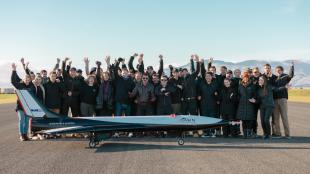Latest CubeSat Reveals First High-Resolution Image of the Earth

While Cal Poly’s ninth CubeSat tests a way to reduce vibrations aboard orbiting satellites, the softball-sized satellite also has been busy snapping photos of the Earth.
DAVE, or Damping and Vibrations Experiment, launched Sept. 15 from Vandenberg Air Force Base with three other small satellites, or CubeSats, as secondary payload on NASA’s ICESat-2 (Ice Cloud and Land Elevation Satellite-2) mission.
PolySat, the student-run research lab, released its first high-resolution image that was snapped just hours after the launch. The photo shows Svalbard, the Norwegian archipelago located between Norway and the North Pole.
“This is one of our better pictures,” said Grigory Heaton, a senior studying aerospace engineering and physics. “Our satellite is not controlled. It’s just spinning, so we have to get lucky with the pictures. This one, we were right overhead and got almost the entire archipelago.”
The download rate from the 2-pound satellite is half a kilobyte per second, meaning it can take 45 minutes to download a 1.3-megabyte image. Students first must contact the satellite as it passes over the campus. Next, they capture a fuzzy, low-resolution thumbnail; anticipation grows while the full-size photo slowly downloads — typically in 8-minute increments spread over several days.
This was especially true back in September. “We were waiting to hear back from the satellite,” said PolySat member Michael Fernandez, a physics junior from Glendale, Calif. “When we did and started downloading the photos, initially we weren’t sure what they really were. So getting a photo that is really meaningful — and cool — as our first full-resolution image is very special.”
The camera lens was apparently damaged during launch. All the images have a dark splotch near the center, possibly the result of being struck by an outgassed particle on the satellite, Fernandez said.
DAVE was designed and built by Cal Poly students, working with Northrop Grumman Aerospace Systems, to study the behavior of particle dampers in microgravity conditions. In space-based applications, particle dampers could potentially serve as a robust and simple device to eliminate jitter in orbital assemblies or other sensitive scientific equipment at a reduced cost compared to existing technologies.


